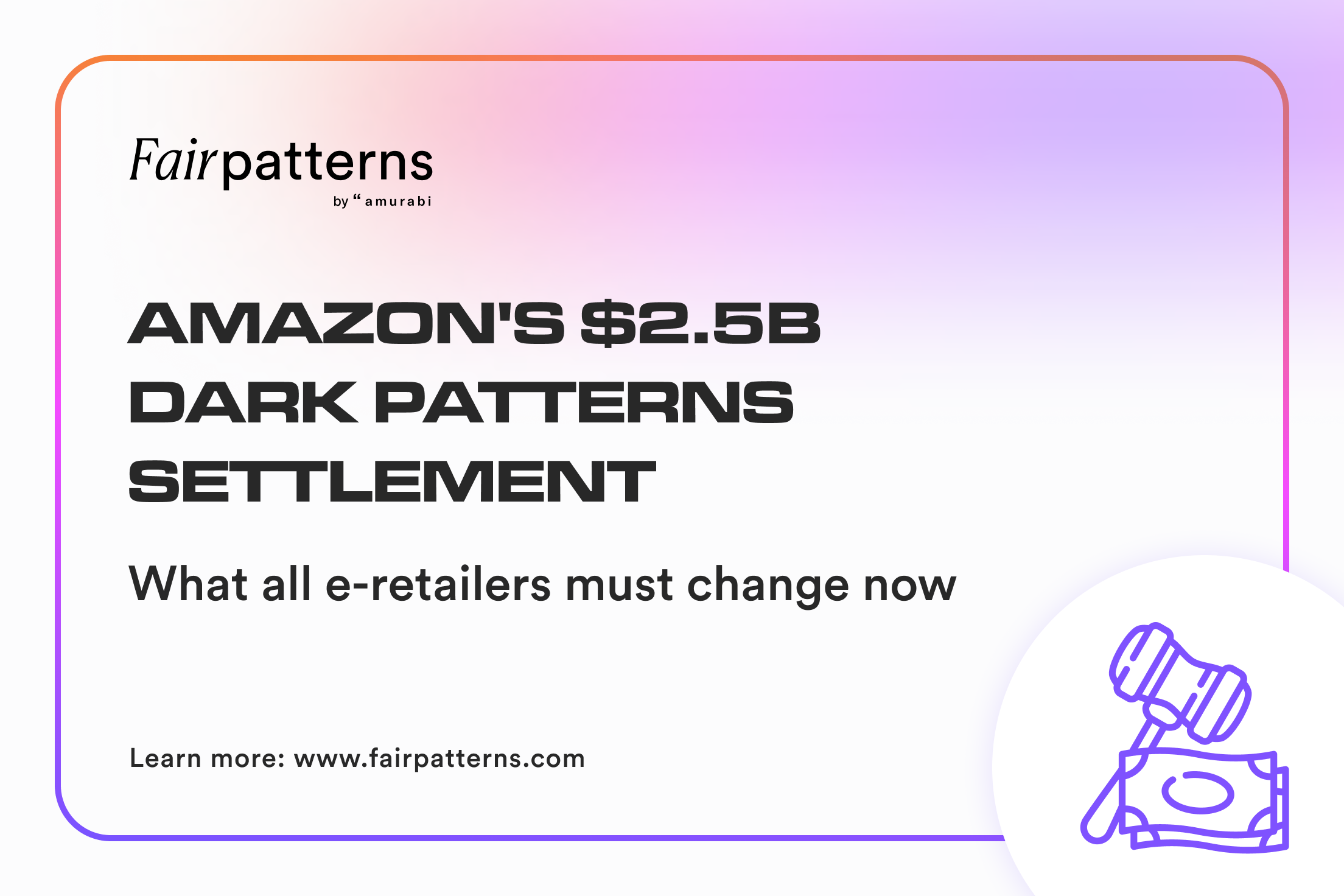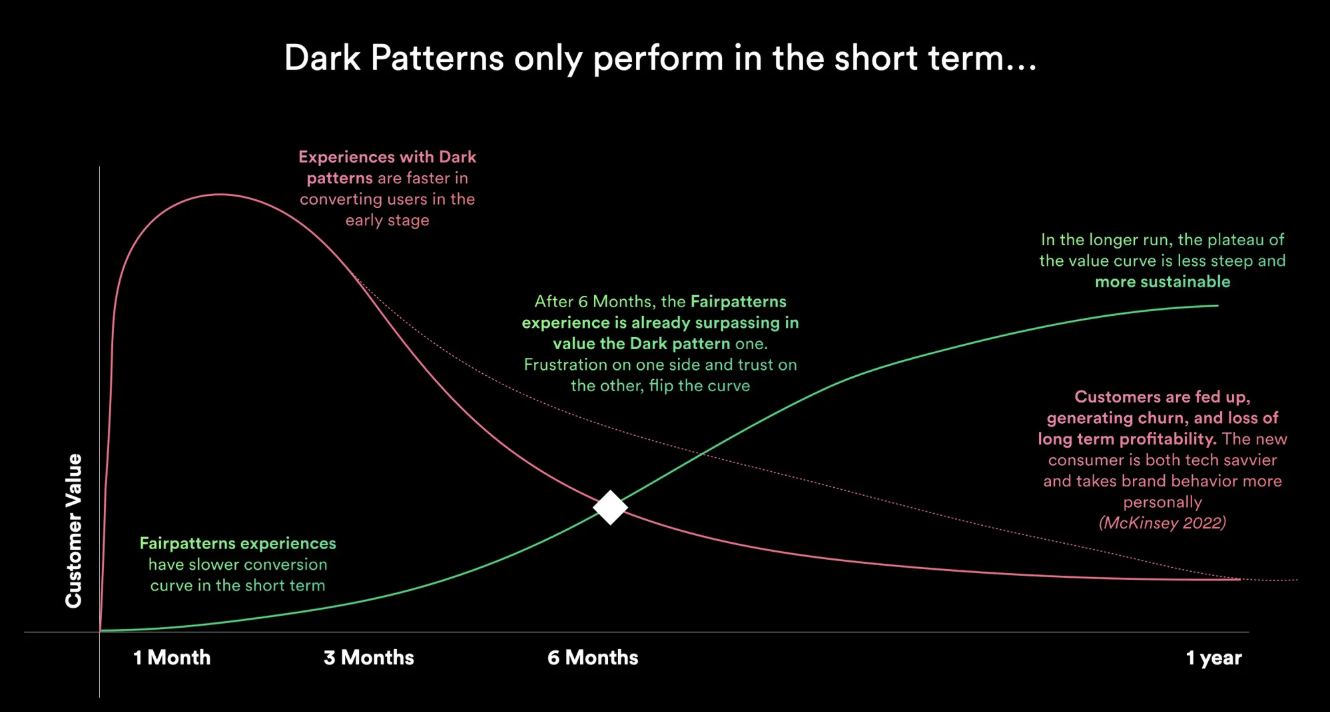Amazon's $2.5B dark patterns settlement: What all e-retailers must change now

Introduction
On September 25, 2025, Amazon settled with the Federal Trade Commission for $2.5 billion ($1 billion in penalties + $1.5 billion in consumer refunds) after being caught using dark patterns to trap 35 million consumers in unwanted Prime subscriptions and making cancellation particularly difficult.
This landmark case establishes that manipulative design is not just illegal, but leads to severe financial consequences and personal executive liability.
How Amazon trapped 35 million users with illegal dark patterns?
Amazon violated federal consumer protection laws by using deceptive design tactics, known as dark patterns, in two critical areas:
- Deceptive User Interface: During checkout, Amazon displayed a prominent button reading "Get free delivery with Prime" that actually enrolled users in a $14.99/month recurring subscription without making this clear. The option to purchase without Prime was hidden in small, hard-to-find links. A sadly classic dark pattern known as “hidden subscription” or “roach motel”.
- Obstructive Cancellation: Amazon created what employees internally called the "Iliad Flow" (named after Homer's epic poem about the decade-long Trojan War). Canceling Prime required navigating four pages, making six clicks, and choosing from fifteen options. At each step, users were dissuaded from cancelling, using a variety of trick and traps. Meanwhile, signing up took just one click.
This violated the Restore Online Shoppers' Confidence Act (ROSCA), which requires companies to clearly disclose subscription terms before collecting payment and make cancellation at least as easy as enrollment.
What laws did Amazon violate?
Amazon broke two federal laws:
ROSCA: This 2010 law requires companies to (1) clearly disclose all subscription terms before collecting billing information, (2) obtain express informed consent, and (3) provide simple cancellation that's as easy as sign-up.
On September 17, 2025, Judge John Chun ruled Amazon violated ROSCA by collecting billing information before disclosing Prime's $139 annual cost and auto-renewal terms.
Section 5 of the FTC Act: This law prohibits unfair or deceptive business practices. The FTC argued Amazon's dark patterns were both deceptive (misleading consumers) and unfair (causing harm consumers couldn't avoid).
Why did Amazon settle after just 3 days?
After just three days of trial, Amazon settled to avoid devastating evidence:
- Damaging Internal Communications: Discovery revealed Amazon employees called Prime enrollment "a bit of a shady world" and described unwanted subscriptions as "an unspoken cancer." One email referenced executives as the "chief dark arts officer."
- Document Hiding Scandal: Amazon initially withheld 70,000 documents by falsely claiming attorney-client privilege. When forced to review these claims, Amazon withdrew 92% of them. On June 23, 2025, Judge Chun sanctioned Amazon for "bad faith" conduct that appeared motivated by "the desire to gain a tactical advantage."
- Expert Witness Excluded: On August 11, 2025, the court excluded Amazon's key expert witness who claimed dark patterns were subjective, finding his testimony lacked reliable methodology.
- Personal Executive Liability: Two Amazon executives, Senior Vice President Neil Lindsay and Vice President Jamil Ghani, faced personal liability if found guilty, creating enormous pressure to settle.
What does Amazon have to pay and change?
Financial Consequences:
- $1 billion civil penalty (largest ever for FTC rule violations)
- $1.5 billion in refunds to 35 million affected consumers (up to $51 each)
- Provide clear decline buttons without guilt-inducing language like "No, I don't want Free Shipping"
- Disclose all material terms (cost, billing frequency, auto-renewal, cancellation method) before collecting billing information
- Make cancellation as easy as enrollment
- Submit to independent third-party compliance monitoring
Interestingly, these requirements correspond to what we’ve been advocating for at Fair Patterns for years, and to the library of fair patterns we created back in 2023, that was assessed by ten independent experts.
.png)
.png)
Can company executives be held personally liable for dark patterns?
Yes. This case established a critical precedent: executives who knowingly implement or maintain dark patterns face personal liability, not just corporate penalties.
The FTC named Neil Lindsay and Jamil Ghani as individual defendants, and the court ruled both could be held personally liable if proven they had knowledge of illegal practices. This creates personal accountability beyond corporate fines.
Key takeaway for executives: Internal communications acknowledging problematic practices become evidence of knowledge and intent. Amazon's own emails about "shady" practices were used against its leadership.
Who is eligible for Amazon Prime refunds?
You may receive an automatic refund up to $51 by December 25, 2025 if you:
- Signed up for Prime through challenged enrollment flows between June 23, 2019 and June 23, 2025
- Unsuccessfully tried to cancel during that period
- Used no more than three Prime benefits in any 12-month period after enrollment
No action required: eligible customers receive automatic refunds. In 2026, Amazon will open a claims process for additional eligible customers.
Important: The FTC never asks for payment to receive refunds. Anyone demanding fees or personal information for Amazon refunds is running a scam.
What Does This Mean for the Future of Digital Design?
The Amazon settlement transforms fair design from ethical aspiration to legal requirement:
- From Ethics to Law: Dark patterns are no longer just bad practice—they're illegal conduct with billion-dollar consequences and potential executive liability.
- Increased Enforcement: Expect heightened regulatory scrutiny of subscription practices across all industries as the FTC continues prioritizing consumer protection.
- Consumer Empowerment: The $1.5 billion in refunds to 35 million consumers proves challenging unfair practices yields real results.
- Business Case for Fair Design: While dark patterns may boost short-term metrics, long-term costs (settlements, reputation damage, lost trust) make them economically irrational. Interestingly, we had already evidenced that Fair Patterns are more profitable than dark patterns after just 6 months, even without taking into account this settlement.

Conclusion: Fair Design Is Now a Legal Requirement
The Amazon Prime settlement closes the era when companies could use manipulative design with impunity. With $2.5 billion in penalties, personal executive liability, and mandatory operational changes, the case establishes that fair design is no longer only a competitive advantage: it's a legal requirement.
- For companies: Audit your practices for dark patterns, implement fair enrollment and cancellation processes, and build compliance into product development from the start.
- For consumers: This demonstrates that challenging unfair practices works—35 million people will receive compensation, and Prime's design must change to respect user autonomy.
- For the digital ethics community: The principles of transparency, user autonomy, informed consent, and symmetrical design are now established legal standards with federal enforcement behind them.
The future of digital design is fair by design: not as aspiration, but as requirement.
Legal References:
- FTC Settlement Order
- Restore Online Shoppers' Confidence Act (ROSCA), Pub. L. No. 111-345
- Federal Trade Commission Act, Section 5, 15 U.S.C. § 45
References:
- https://www.courthousenews.com/wp-content/uploads/2025/05/ftc-sanctions-amazon.pdf
- https://www.ftc.gov/legal-library/browse/cases-proceedings/2123050-amazoncom-inc-rosca-ftc-v
- https://www.ftc.gov/system/files/ftc_gov/pdf/Amazon-ROSCA-Order-Filed_0.pdf
- https://www.ftc.gov/news-events/news/press-releases/2025/09/ftc-secures-historic-25-billion-settlement-against-amazon
- https://www.cnbc.com/2025/09/25/amazon-ftc-prime-settlement.html
- https://www.ftc.gov/enforcement/refunds/amazon-refunds
Protect Your Company. Respect Your Users.
Explore Fairpatterns tools:
















































